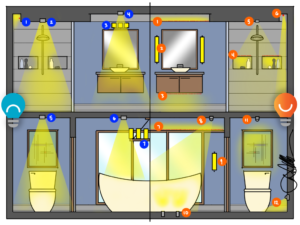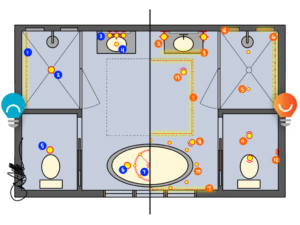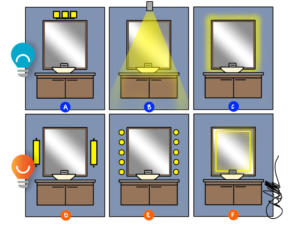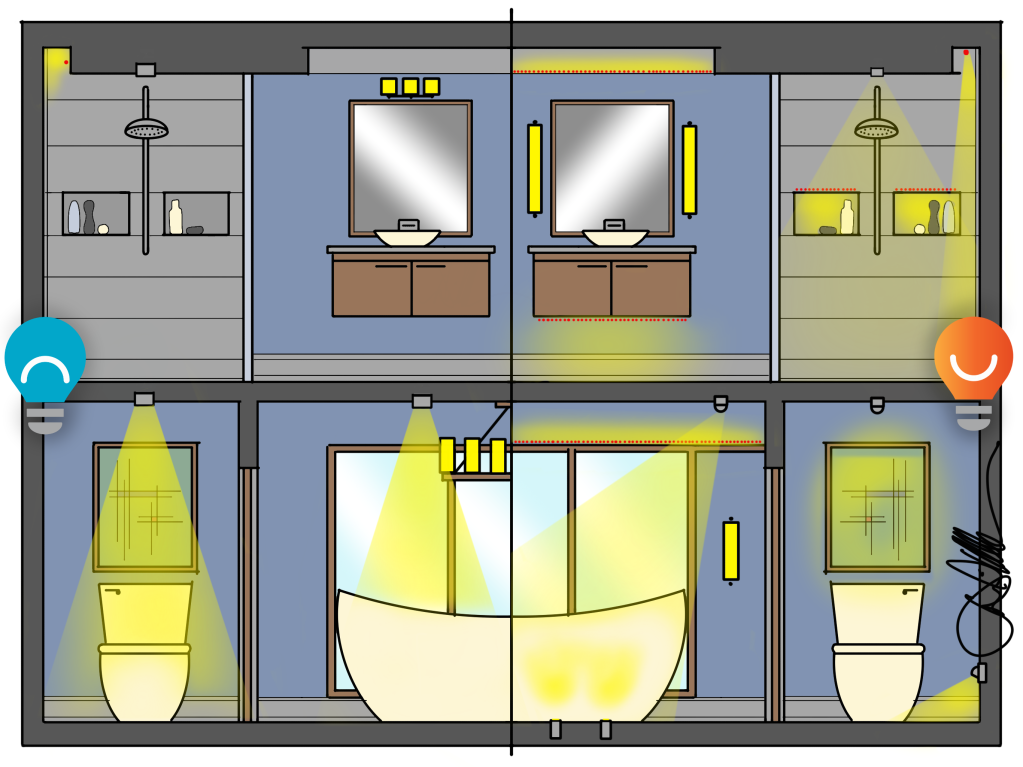My desire to revisit the do’s and don’ts of lighting is going to kill me, but I am having too much fun to stop. These posts take the longest to create of any I have previously written, but sketching is so relaxing that I look forward to the next one. So here it is, the third month of my series, and I’m back at it again with baths.
If the past two posts are any indication, this one is going to get long. So I’ll attempt to create an executive summary of good lighting for bathrooms here:
- Don’t shine light in your eyes. Disk lights in bathrooms are a no-no, as are recessed downlights over tubs.
- Don’t make yourself look ugly. Avoid shadows on your face at the mirror by surrounding it with soft, flattering light.
- Do provide low-level lighting for night. Help yourself wake more gently and relax more easily with lights down low, under vanities, in water closets, and in shower niches.
- Do shine light where you need it. Use adjustable recessed downlights to highlight your hair, illuminate a book in the tub, and accent artwork on the wall. The shower is about the only place in the entire home well-suited for non-adjustable downlights, and that has more to do with water infiltration than light quality.
Okay, for those of you who want to dig a little deeper, buckle your seatbelts. Let’s talk about lighting in baths.

Some of the most common mistakes- or missed opportunities- show up time after time when we see lighting layouts in homes ranging from moderate to luxury. Here are a few:
- Light trapped in pockets. A lovely reveal in a shower can highlight tile and provide a more energetic setting, but linear “tape” light placed incorrectly mostly just draws our attention away from the lovely stone or tile.
- Bright lights in showers. This is a bit of a trick question, as bright light in showers can be great when trying to wake up. But bright downlights without dimmers can be disruptive at night, and on their own make showers a rather unpleasant place to be.
- Lights over mirrors. I understand this is the most common and easiest place to put a light fixture, but that does not mean I like the shadows under my eyes and the dark places under my chin that result.
- Downlights over sinks. I love how the sink looks with a downlight overhead, but I do not like the grim reaper look on my face that goes with it. I’d rather have my face look good than the sink, so I’ll put the light somewhere else.
- A single recessed downlight in a water closet. This most humble of spaces does not need cave-like lighting from a recessed downlight. It may not even be best for reading, though we may think so.
- Downlights over tubs. No. Fill up the tub, toss in some bubble bath, and lean back…and stare straight into the bright light shining in your face. Ahh….
- Chandeliers over tubs. If you must, at least keep them to code, which generally requires them to be no lower than 8’. Why? Because when you start to slip getting out of the bath, you’ll grab whatever is closest without wondering whether it is electrified or not.

So what could you do in a bath? What lighting might I recommend? Every bath is different, so the solutions here are by no means exhaustive. Consider them a sign post that points in the right direction, not a step-by-step printout from Mapquest. (Remember Mapquest? That tells you how old I am).
- Light your tray ceilings. It makes me sad when I see tray ceilings that go dark at night. And you’ll miss the opportunity to fill the bathroom with soft, gentle light.
- Light your face. Long, soft shaded lights on either side of the sink are best for making you look good. They also make it easier to see where you are grooming.
- Light under vanities. Light down low will make it easier to see where you are going at night without putting too much light in your eyes.
- Light the niche. This requires a little coordination between your electrical contractor and your tile setter, but the result is a more relaxing shower.
- Downlights in the shower. Yes, I said don’t do this above, but the real story is that doing only a recessed downlight in the shower is not great. Adding a few recessed downlights, highly shielded (not bright to the eye), can be very beneficial as part of a complete strategy. This may be tough to believe, but I do not have a vendetta against downlights. I have a vendetta against homes only illuminated with downlights.
- Graze the stone. Performance linear grazers, like tape light with precision lenses, can push light out of slots and down where our eyes will appreciate it.
- Indirect light. No tray ceiling? No problem. A simple piece of trim can conceal today’s miniscule LED lighting and give you a soft glow with a flat ceiling.
- Light your book. Recessed adjustable downlights placed on either side of the tub can shine over your shoulders and illuminate the tub without blinding you as you lean back. I prefer modern versions of gimbal/eyeball lights that hide the mechanisms in the ceiling for a cleaner look.
- Light your walls. Sconces may not be a good idea too near a tub, for the same reasons chandeliers are against the building code, but elsewhere in a bathroom they might fit nicely.
- Add electric candles. The perfect illumination for a relaxing soak is a few dozen candles, but by the time you have set them up and lit them, you’ll be too tired for the bath. Carefully placed electric lights, either in the floor or in walls, can provide some of that warm glow at the push of a button.
- Use adjustables for art. Can you tell I love these things? Light the art or photos in a water closet, or accent a wall, and the light will bounce off and make the space more comfortable – and you will also be able to read your newspaper.
- Install a night light. Recessed steplights, most often seen outdoors or in modern stairwells, make excellent permanent night lights in water closets. This makes it easy to use in the middle of the night while reducing sleep disruption – just make sure to place it facing away from the bedroom to minimize disturbing who you left behind.
- Highlight your hair. Got room for one more adjustable recessed downlight? Place it a couple of feet behind the front edge of your vanity and point it at your shoulders. You’ll look like a Hollywood star in front of the mirror. Trust me on this one.

Speaking of mirrors, the vanity itself often deserves a little more consideration that it receives. There are a number of ways to provide good lighting at the sink- and a number of ways that do not do so well.
- Don’t put vanity lights above the mirror, if you have any other option. These are passable in a seldom-used bathroom, but leave too many shadows for daily use.
- Avoid recessed downlights over the sink as your primary source of light (see Don’t #4 above).
- Backlit mirrors are not functional. This is a lovely, moody look in the bathroom of a nice restaurant or club, but you will struggle to see your face. It’s okay to use this effect, but not for functional light.
- Large, soft-shaded wall sconces on either side of the sink are great for illuminating your face.
- If you really want to look good, go for the backstage specialty of rows of soft globes on either side of the mirror. It may look a little outdated, but your face won’t.
- Illuminated mirrors. Mirrors with built-in light sources can provide a decent amount of soft light to fill in the shadows, though their recessed nature makes them a little less ideal than D and E.
If I seem to be repeating myself, that is because good lighting is always about using the right light in the right place at the right time to do the right thing. That’s it. Room after room.
WARNING: Simplifying the science, geometry, biology, and psychology of the entire profession of lighting design into a single blog post should set off alarm bells in your mind. What I have put here is by no means a replacement for a professional designer. But since most of us live in homes far removed from professional designers, these ideas would be a crazy dramatic improvement on what we usually endure.
Read more DON’T/DO THIS posts HERE. This is a new series for 2023, so check back monthly for more.
